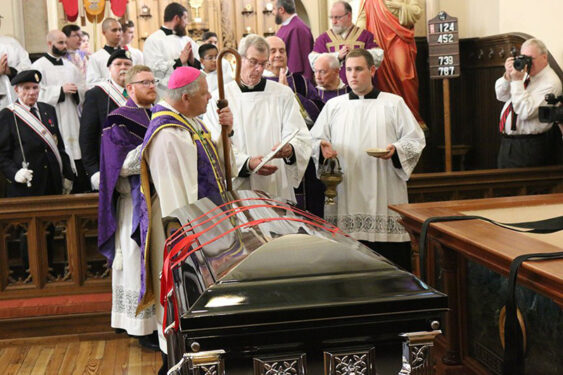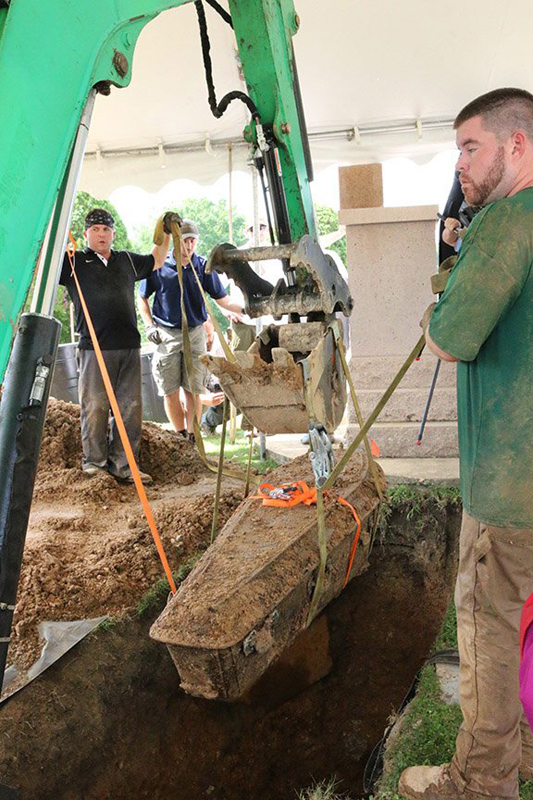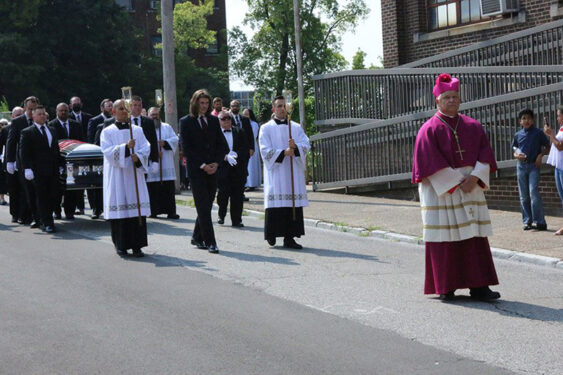
By Dan McWilliams
CHATTANOOGA, Tenn. (CNS) — At 10:50 on the morning of July 27, Father J. David Carter’s voice rang out at Mount Olivet Cemetery in Chattanooga: “We are about to lift the coffin from the grave.”
And with that, the sainthood cause of Father Patrick Ryan, who has the title “Servant of God,” took a crucial step, as the exhumation of his remains for reentombment at the Basilica of Sts. Peter and Paul could proceed.
Bishop Richard F. Stika of Knoxville, Tennessee, attended the exhumation of the former Sts. Peter and Paul pastor, who died in 1878 in the yellow fever epidemic in Chattanooga as he selflessly ministered to victims of the plague that eventually claimed his own life.
Father Carter, basilica rector and episcopal delegate for the sainthood cause, was present at the digging along with a team of experts and witnesses. The team included Dr. Barbara Golder, a medical witness, and Deacon David Keene, an archaeologist with the Archdiocese of Chicago.

Also attending were Deacon Gaspar DeGaetano, postulator for the sainthood cause, and Deacon Hicks Armor, notary for the cause. Both serve at the basilica parish. Father John Orr, pastor of St. Mary Parish in Athens, Tennessee, attended as the promoter of justice for the cause.
Temperatures above 90 degrees made the gravediggers’ work, which began July 26 and concluded very late the next day, especially arduous. They toiled for some five hours the first day before finally reaching Father Ryan’s coffin 8 feet below Priests’ Mound.
“We started digging about 10 in the morning (on July 26),” Deacon DeGaetano told The East Tennessee Catholic, newspaper of the Diocese of Knoxville. “They had a break for lunch, and then they continued digging in the afternoon. We found what seemed to be a little votive garden only about 3 feet underground.
“There were what looked like carved pots for flowers or votive candles, and kind of a concrete thing that might have been a shrine. It’s hard to tell what it was. … We also found pieces of glass, like there might have been votive candles used there.”
The painstaking work resumed at 9:30 a.m. July 27 as volunteer gravediggers Brandon and Nelson Panganiban labored to remove dirt around and below the casket and prepared it to be lifted by excavator operator Frank Brogden.
More than two hours after work restarted and the coffin was raised, Bishop Stika conducted a prayer “that the people of God might be edified by the heroic example of this faithful priest, and that the hearts of many might be drawn closer to you, the Divine Shepherd of our souls, as we hold up the example of one who sought to imitate his pastoral ministry in this community. We give thanks for the life of Father Ryan and for all those priests who have given their lives throughout the epidemic of yellow fever in that era.”
Yellow fever is a mosquito-transmitted viral disease. It can cause serious illness and even death. It received its name because the skin of seriously ill people turns yellow, a condition known as jaundice.
The disease made its way to Chattanooga from Memphis, which experienced a serious outbreak of illness from 1873 to 1879. In Memphis, 23 women religious who treated the seriously ill died from the disease.
Father Ryan’s coffin was sealed with several metal bolts, so the cemetery workers cut them with handheld grinders and then drilled out the holes. Still, the lid remained tightly shut. The workers continued grinding along the edge of the coffin’s lid and finally used crowbars to carefully open the casket.
Finally, after two more hours, the lid was opened. The first thing witnesses noticed inside the coffin was broken glass from the metal box’s viewing window. As Deacon Keene narrated the process of removal for everyone, a mandible with teeth and a skull were soon discovered, as well as a crucifix.
Soon, Golder detected the possible presence of arsenic in the coffin, and the day’s efforts were suspended until the team could bring in environmental experts the next day. Arsenic was sometimes used as an embalming fluid in Father Ryan’s day.
Work on the removal of the remains resumed July 28 with the environmental safety precautions in place.
“We found vestments that were still intact,” Father Carter said. “We found an extra stole that may have been used in his ministry when he went door to door to visit the yellow fever victims. We found a full set of bones. His bones were intact. The arsenic led to the preservation so well of his mortal remains.”
A service company that specializes in remediation of hazardous materials and environmental safety was called in. Its professionals carefully removed the remains from the coffin, treating them respectfully, washed them and handed them to diocesan medical experts, Father Carter explained. Father Ryan’s body was then reconstructed in a new casket.
The cause of Father Ryan’s sainthood is most important to the Diocese of Knoxville, Bishop Stika said.
“It’s very significant. For a young diocese, we have a new cathedral, a basilica, and now this is so significant because a pastor of the parish of Sts. Peter and Paul is now a Servant of God, and we’re hoping soon that he will be declared venerable by the pope,” he said.

